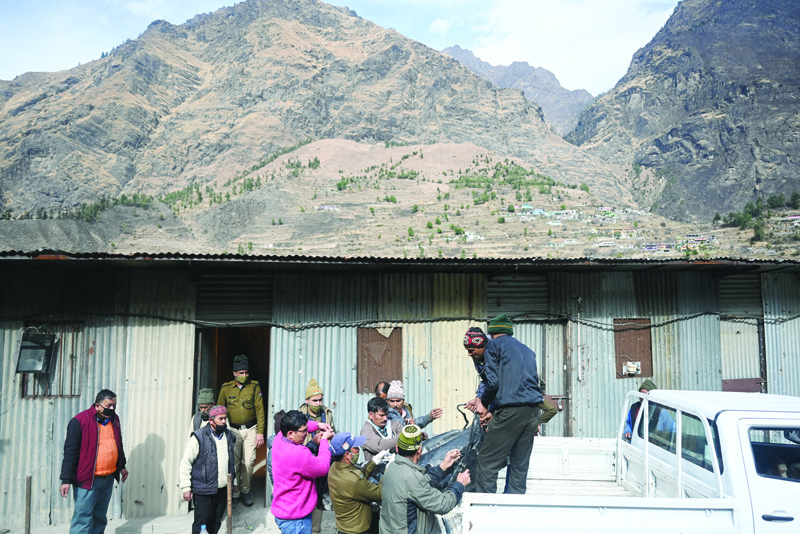 Relatives load on a vehicle the body of a victim recovered from Raini village, outside a temporary morgue in Tapovan of Chamoli district yesterday following a flash flood thought to have been caused when a glacier burst on February 7. -- AFP
Relatives load on a vehicle the body of a victim recovered from Raini village, outside a temporary morgue in Tapovan of Chamoli district yesterday following a flash flood thought to have been caused when a glacier burst on February 7. -- AFP
TAPOVAN, India: Indian rescue workers battled through tons of rock and mud yesterday searching for survivors in a choked Himalayan tunnel after a deadly flood-apparently triggered by a glacial burst-smashed through two mountain dam projects. More than 170 people were still missing, two days after a wall of water and debris hurtled down a valley in the northern state of Uttarakhand, destroying bridges and roads, hitting two hydroelectric power plants and killing 31.
The disaster has been blamed on rapidly melting glaciers in the Himalayan region caused by global warming. Building activity for dams and dredging riverbeds for sand and the clearing of trees for new roads-some to beef up defense on the Chinese border-are other factors. Most of those missing were employees at two of the many hydro plants being built around Uttarakhand, home to soaring Himalayan peaks and the sources of the Ganges river. Hundreds of rescue workers were involved in the operation across the state, using helicopters equipped with surface-penetrating high-definition cameras, as well as sniffer dogs.
Yesterday the focus was attempting to locate and extract 34 workers who were in a network of tunnels when the 20-metre-high (70-foot) barrage of icy water and debris roared through on Sunday morning. Workers toiled all night and police official Banudutt Nair, in charge of the rescue operation, told AFP he believed that there were air pockets where the employees could still be alive. "Forty-eight hours have passed and it has become a race against time. We hope they survive but there's been no contact so far," army rescuer Vivek Sahai said.
Giant floodlights lit up one entrance late Monday as a huge excavator slowly extracted the sludge which rescuers then sifted through. Nearby, workers used heavy machinery to remove giant boulders from the road blocking the way to the second power plant, Rishi Ganga, where 35 people were missing. The plant was obliterated and is now a wasteland thickly coated with viscous grey mud. At a nearby village, four bodies were recovered yesterday including that of a policeman. Building projects crisscross highly-seismic Uttarakhand state despite warnings from scientists about the impact on its ecologically fragile hills and valleys.
'Don't let go'
One of those who made it out was Rajesh Kumar, 28, who together with others clung to scaffolding rods in the tunnel for four hours before the water level fell and they were able to escape. "Suddenly there was a sound of whistling... there was shouting, people were telling us to come out. We thought it was a fire. We started running but the water gushed in. It was like a Hollywood movie," Kumar told AFP.
"We just kept telling each other-come what may, we must not let go of the rods," he said from his hospital bed. Shopkeeper Ramesh Negi was enjoying the Sunday morning sun when he heard a loud roar and saw a huge wall of water smash into and sweep away a bridge. Dozens of workers on the river bed and grazers leading their cattle along the mountain slopes disappeared beneath the sudden deluge, he recalled.
"There was dust and screams all over," the 36-year-old said. "We tried to alert the grazers but they were blown away by the wind pressure before being consumed by the water and slush. We can only guess what happened." Mangra, another survivor, remembered hearing a loud, rumbling sound and the screams of other colleagues: "Run, run, run!" The 28-year-old scrambled out of the tunnel but six of his friends and neighbors from his village didn't make it. "It felt like the mountain was crashing and the Earth was moving," Mangra said outside the tunnel, cuts and scrapes on his hands and legs. - AFP




